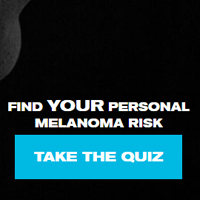Education

Melanoma is the least common type of skin cancer, but the most deadly.
Melanoma arises from pigmented cells called melanocytes, and it most often occurs in melanocytes in the skin or in moles. Less often, melanomas form in other parts of the body, such as the eyes and mouth.
Melanomas develop when unrepaired DNA damage to skin cells (most often caused by ultraviolet radiation from sunshine or tanning beds) triggers mutations (genetic defects) that lead the skin cells to multiply rapidly and form malignant tumors.
Key things to know:
- Early detection is critical -- melanoma is almost always curable when found early, but can become increasingly deadly if allowed to spread and grow deeper into the skin.
- Practicing sun safe habits can help prevent melanoma -- exposure to ultraviolet rays, from the sun or tanning beds, is a main cause of melanoma.
- Your eyes can be your best tool -- a mole or spot on your skin that is changing in appearance (size, shape, coloration) is a key indicator for melanoma.
To learn more, you can utilize the resources below:






